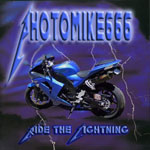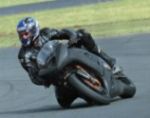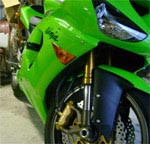Part 2. Performance Bikes Suspension Set up guide
Diagnostics
Two important points to have before you start, one is the static sag right, and the other is a good starting point that you can revert back to if it all goes wrong. Set the compression damping adjusters to minimum, set rebound damping to half way – ride the bike to get a feel for it.
In general, bike suspension has limited adjustment, so a big change will be easier to feel than a small one. Also, even if rebound damping has 40 clicks it will probably only make a difference in the last five.
Issues, possible causes and cures
General
Compression damping affects how much the bike moves around when it first does something (brake, accelerate or turn).
Rebound damping helps hold it steady afterwards.
Quite often adjustments have effects that are completely different to what you expect. This is because adjustments (and problems) sometimes overlap and something changed at the back end manifests itself at the handlebars. If you alter the front suspension to compensate it may not have the desired effect. Therefore only make one change at a time and keep notes on any changes you make.
Steering
Slow heavy steering, or bike sits up under braking, or runs wide into corners. You need to raise the rear or lower the front by:
A) Increasing the rear ride height adjuster if your bike has one
B) Increase the rear preload
C) Increase fork rebound damping
D) Increase rear damping
E) Drop the yokes down the forks
F) Raise the rear by fitting a longer spring, a washer on top of the rear shock or change the shock linkage (expensive.
All these will make the steering lighter and faster, but will possibly cause the front to become twitchier or give tankslappers. Reverse/reduce amount of change to settle it down.
Mid corner wobbles
Usually caused by poor maintenance, but if bike is in A1 nick and corners like a boat
A) Increase the rebound damping front and rear
B) Check for a mismatch of front and rear settings
Tankslappers
Common due to high power, low weight and steep head angles aimed at quick steering
A) Raise front or lower rear
B) Reduce front rebound damping
C) Increase front compression damping
D) Change your riding style; under power, sit up against the tank and put your weight over the front. Keep a light touch on the bars – don’t lean on them – and take your weight through the pegs.
Braking
A) If the front dives too much on the brakes, increase the front compression damping
B) If the bounces back after braking, increase front rebound damping
C) If the rear end chatters or leaves the ground under braking, decrease rear rebound or sit further back
Under power
Even bikes that handle badly handle less badly under power. The bike is driving from the rear, the rear tyre works harder then the front and the bike naturally holds a tight line.
A) If the bike squats too much, increase the rear compression damping
Performance Bikes Suspension Set up guide Part 2
9 posts
• Page 1 of 1
Performance Bikes Suspension Set up guide Part 2
--------------------------------------------------------------------------------------------------------------
07 ZX10R since new, tracky TBA, KX450F, 87 CR250 restoration, GT MTB - I've got serious thrill issues, dude
07 ZX10R since new, tracky TBA, KX450F, 87 CR250 restoration, GT MTB - I've got serious thrill issues, dude
-

photomike666 - Apprentice Post Whore :-)

- Posts: 5956
- Joined: Sat Jan 15, 2005 12:01 am
- Location: Melbourne
- Bike: ZX10R
- State: Victoria
During my last track day i increased the front compression dampening to within half a click of max to match the rear and damn it made a huge difference! 
Held a line with ease and felt very stable and predictable thru corners it was previously squirming around thru.
Thought i was going heaps faster as a result, but no, lap times the same.
I haven't touched my front or rear rebound settings, they are still stock.
I'm still very new to suspension tuning.
Held a line with ease and felt very stable and predictable thru corners it was previously squirming around thru.
Thought i was going heaps faster as a result, but no, lap times the same.
I haven't touched my front or rear rebound settings, they are still stock.
I'm still very new to suspension tuning.
Realise your most cherished desires by defending them from your casual wishes.-George S Clason
-

varden - KSRC Regular

- Posts: 669
- Joined: Sun Jul 10, 2005 6:59 pm
- Location: Brisbane, Qld
- Bike: ZX10R
- State: Queensland
Smitty wrote:good stuff Mike
but two points-
good tyres are a must
and
make sure ya suspension isn't worn or needing new oil/replacement
cheers
exactly
had a BT010 on the 400 and its a very flat profile , picked up another bike with a pilot race and it has a very sharp profile and makes for nice quick steering , love em
- Johnnie5
- KSRC Regular

- Posts: 546
- Joined: Sun Nov 21, 2004 8:30 pm
- Location: Marayong
this is a very interesting thread but ive always wanted to play around with my front suspension setup but im too chicken to and dunno where to start.
the only thing ive done is stiffen the rear.
my question here is, it is necessary to change the front suspension setup for the streets? mine is already kinda stiff but if i change it, would it benefit me on the streets?
the only thing ive done is stiffen the rear.
my question here is, it is necessary to change the front suspension setup for the streets? mine is already kinda stiff but if i change it, would it benefit me on the streets?
-

GForce - KSRC Member

- Posts: 269
- Joined: Sun Jul 16, 2006 1:53 pm
- Location: Adelaide
- Bike: ZX6R
- State: South Australia
Ride quality is more important for the streets. Your hard pressed to find the limits of your suspension set up on the road even if its stock.
i always found myself winding off the compression and rebound dampening for the road so it was less bone jarring.
But then i discovered i had only 25mm of rider sag in my rear susp so backing off the preload a HEAP would have helped that.
i always found myself winding off the compression and rebound dampening for the road so it was less bone jarring.
But then i discovered i had only 25mm of rider sag in my rear susp so backing off the preload a HEAP would have helped that.
Realise your most cherished desires by defending them from your casual wishes.-George S Clason
-

varden - KSRC Regular

- Posts: 669
- Joined: Sun Jul 10, 2005 6:59 pm
- Location: Brisbane, Qld
- Bike: ZX10R
- State: Queensland
Varden said "Held a line with ease and felt very stable and predictable thru corners it was previously squirming around thru.
Thought i was going heaps faster as a result, but no, lap times the same."
BUT you have the POTENTIAL to go faster now ??
Right up to the point where it is squirming again.
Thought i was going heaps faster as a result, but no, lap times the same."
BUT you have the POTENTIAL to go faster now ??
Right up to the point where it is squirming again.
Just because you CAN ride, doesn't mean you SHOULD
- FrogZ
- KSRC Contributor

- Posts: 2090
- Joined: Tue Apr 11, 2006 12:58 pm
- Location: Rockhampton CQ
GForce wrote:this is a very interesting thread but ive always wanted to play around with my front suspension setup but im too chicken to and dunno where to start.
the only thing ive done is stiffen the rear.
my question here is, it is necessary to change the front suspension setup for the streets? mine is already kinda stiff but if i change it, would it benefit me on the streets?
even more reason to do it on the street as this is where you use all your suspension travel and having a good understanding of it can mean you can change a click or 2 depending on where you are riding and trnsform the bike , once you have ridden a well setup bike you will regret never changing things in the past
check this one
http://www.gostar-racing.com/informatio ... 0bike%20up
there is plenty more info on the web
http://www.bikepoint.com.au/portal/alia ... fault.aspx
http://www.off-road.com/dirtbike/mar99/ ... shock.html
http://www.racetech.com/homestreet.asp?showPage=street
http://www.ansusa.com/SuspensionGuide.htm
good late model base setup info
http://www.sportrider.com/tech/146_0006_susp/
http://www.wotid.com/tls/
http://www.unofficial-afm.com/suspension.html
- Johnnie5
- KSRC Regular

- Posts: 546
- Joined: Sun Nov 21, 2004 8:30 pm
- Location: Marayong
9 posts
• Page 1 of 1
Return to General Tech & Performance Talk
Who is online
Users browsing this forum: No registered users and 13 guests

